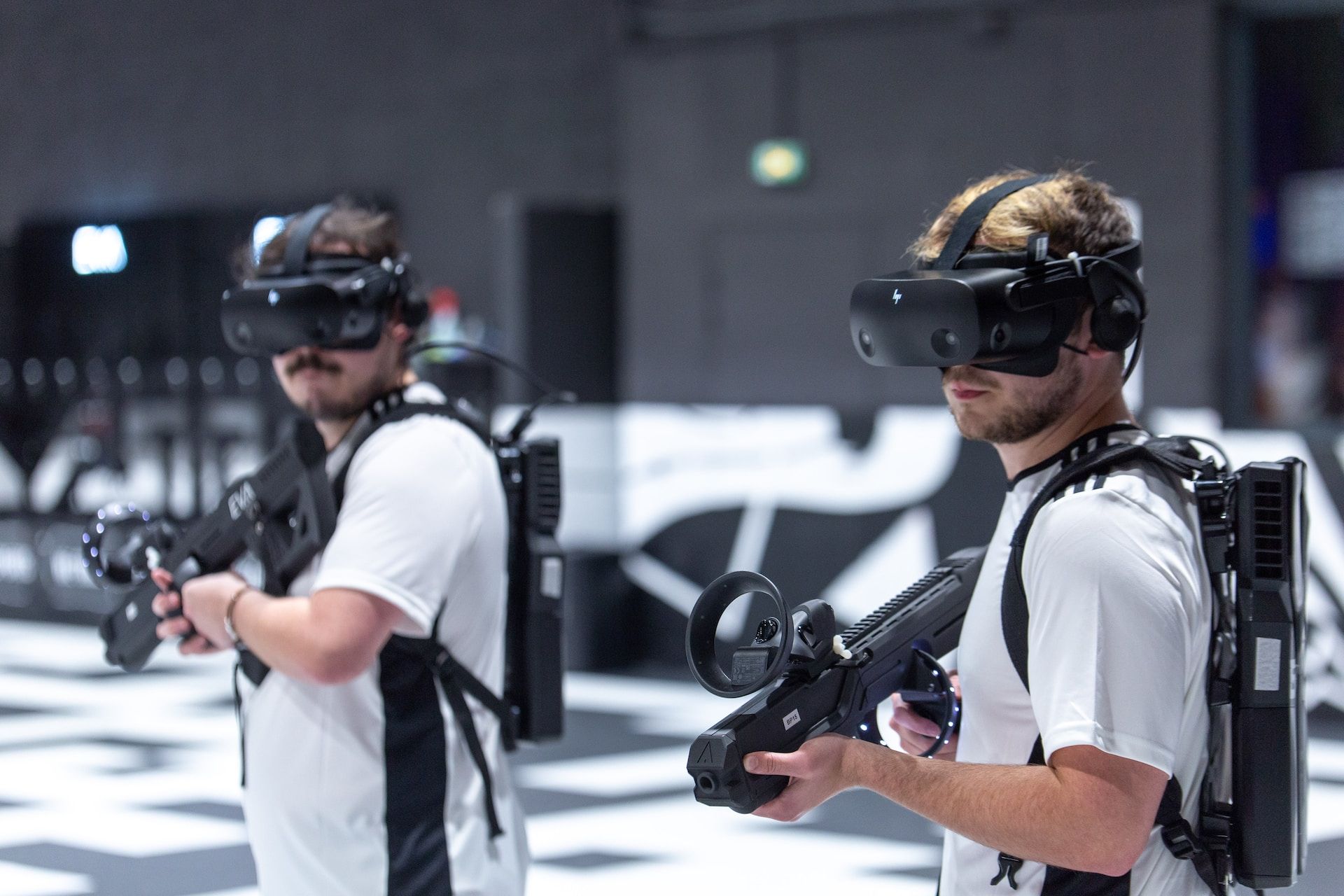July '23: Big game hunter
This month we’ve got a gaming special: we look at where the industry’s at and where we think it’s going, as well as gaming-related podcast and reading recommendations.

Hello and welcome to the July newsletter.
This month we’ve got a gaming special: we look at where the industry’s at and where we think it’s going, as well as gaming-related podcast and reading recommendations.
Also, if you missed it, check out our piece on why we think European tech is just getting started, inspired by the discussions of the European opportunity panels at our Pulse event last month.
Enjoy.
Mattias and the Moonfire team
🌓🔥
What's Up at Moonfire?
Everything everywhere all at once: Gaming investment at Moonfire

Back in 2018, at Atomico, I wrote two pieces about the European gaming market and the evaluation framework we used to assess game companies and founders.
Listening to the Gamecraft podcast (if you haven’t already, go listen to it now) and the gaming panel at Moonfire Pulse 2023 got me excited to dust off the topic. Let’s talk about where the market’s been in the last few years, where it’s going, and how we at Moonfire approach gaming investment now.
Gaming eats the world
A $200bn industry, with three billion gamers, and the largest transaction of 2022 being a $69bn deal between Microsoft and Activision. As board director and investor Megan Quinn put it at this year’s Pulse event, ‘We don’t talk in millions in the gaming industry. We only use Bs.’
And it’s growing well beyond the standard markets. We’re starting to see proof of monetisation and a high ARPU (average revenue per user) across Southeast Asia, Africa, and India, opening up massive markets that new games can go after.
Covid was certainly an accelerant. Time spent gaming increased 39% globally during the pandemic and global video game revenue surged 20% to $179.7bn in 2020, making the game industry bigger than sports and film combined. But it was already trending this way, and there’s little sign of it slowing.
Consumers are expected to spend $185bn on games this year, 70% more than they will allocate to Netflix and co. When Warner Bros released Hogwarts Legacy in February, it took $850m in two weeks – the second-most-successful Harry Potter launch in the film studio’s history.
Even if they were streaming, they’d be watching The Super Mario Bros. Movie, Apple’s Tetris, HBO’s The Last of Us, or gaming clips on YouTube – the biggest content category after music. In the first half of 2021, YouTube saw over 800 billion gaming-related views, over 90 million hours live streamed, and over 250 million uploads. Streaming might have dropped from its pandemic highs, but it’s on a growth trend, and Youtube Gaming was one of the few platforms to recently see its viewership jump – up 25% in December 2022.
Gaming has become a true mass medium. It isn’t competing with other media, it’s eating them. I said in my piece back in 2018 that the next generation of gaming entrepreneurs will look beyond games by default, because there’s a fluidity around platforms, business models and media. That’s only become more true.
Moving platforms
Three major shifts in technology have been reshaping the gaming space over the last few years.
Web3
Web3 gaming’s big problem is that it has yet to create a great game. Repetitive, thin and focused too much on trading assets – gameplay has so far been an afterthought.
But we believe there is still a big opportunity for Web3 principles in gaming. Gamers don’t want the speculation and complication of crypto in their gaming experience, but if Web3 infrastructure could enable ownership and trade in a seamless, invisible way, it could become a more integral part of gaming and allow for new business models. Like our portfolio company GOALS, it’s about building a great game that is enhanced, not defined, by ownership.
At the moment, most of the value of the secondary trade for in-game items is captured by grey markets – a trade which runs into the billions of dollars. Gamers are already used to holding, selling and trading digital items; they just that have to deal with a considerable amount of friction to do it. Web3 infrastructure could make it frictionless, interoperable and secure.
Gaming won’t replace anyone’s primary income, but even getting something back for what you put in, something you own that possesses some interoperable utility and value, is a powerful thing and creates more aligned incentives for engagement.
AR/VR
Every year is hyped as virtual reality and augmented reality’s year, and 2023 has been no different, with the release of the PlayStation VR2 in February and Apple’s recently announced Vision Pro. But the hype’s not unwarranted; it’s just early. Just like AI at the end of last year, AR/VR needs its application layer.
Gaming applications will come first – but they might not look like games. Spatial computing will likely make non-gaming sectors more gamified, whether it be healthcare, education, productivity, or social media.
The evolution of companies like Roblox from a 'games' company to an 'experience' company demonstrates this shift. In essence, Roblox is a next-generation social network – a platform for creating and sharing virtual environments. AR/VR, by providing a yet more physically immersive and engaging platform, could see the growth of these sorts of games at the intersection of user-generated creation and social media and collaborative software. It provides a blank canvas for new digital experiences and storytelling.
AI
The biggest change is AI.
Most exploration so far has been studios experimenting with generative AI to create 2D assets. But as models get better and ML capabilities move on-chip, we will see AI powering life-like, dynamic NPCs (no more “I used to be an adventurer like you…”) and scalable 3D asset generation for more immersive, personalised worlds.
But it’s not just studio-side tooling. Generative AI will upend the way we think about game development and publishing, and what we understand by gaming.
Modding, a tradition as old as video games themselves, requires a pretty sophisticated understanding of a game’s underlying programming. Natural language-driven development gives anyone creative superpowers. It enables a future where anyone can create assets or an entire game on the fly, assisted by AI. You can already use GPT-4 as a co-pilot to help you develop a simple game, even if you don’t have that much experience as a developer. And this is just the first generation. Soon you could watch someone not just stream a game, but watch them create, test and play it in real time. If that gamer gets a lot of interest in that scenario or world, they could then share or sell their creation. You create a world of gamer-developer-publishers.
Two of our portfolio companies are trailblazers in this domain. Scriptic uses generative AI to pioneer phone-first interactive shows at the intersection of games and film – and they envision the tech’s importance in allowing people to develop and distribute their own. Quest Portal is innovating in the realm of tabletop gaming, building tools that help DMs and players generate characters, NPCs, environments, and soundscapes for more immersive D&D and other roleplaying experiences.
AI also has the potential to make gaming more accessible. Take Google’s Project Gameface – a hands-free gaming mouse that allows users to control a computer's cursor using their head movement and facial gestures, which AI translates into actions. AI can also train on specific player patterns to create an adaptable accessibility framework that could be incorporated into games. Such a framework could modify the visual, audio, and interactive aspects of a game to suit individual players, while also circumventing the need for expensive research, custom solutions, or extensive user testing – a boon for smaller creators.
Beyond content: Our approach to gaming investment
Our investment strategy in the gaming sector is organised around four areas: gaming studios, gaming platforms, interactive technology, and infrastructure.
- When it comes to gaming studios and gaming platforms, we think of games beyond the typical definition – whether that’s something like Scriptic, which melds gaming with narrative creation, or a game company that looks like an ed-tech company, delivering education through a digital space. We’re also starting to see companies thinking about how they can create micro games that creators in the gaming space can play with their audience. It’s unclear how this will develop, but it hints at the potential for a creator-led gaming ecosystem. We look for gaming companies that are transforming distribution and community.
- Interactive technology and infrastructure encompasses applications that support the gaming ecosystem and developer tools that underpin game development. Layer AI, for example, uses generative AI to accelerate the game assets creation pipeline, and Immutable’s Passport operates as both an onboarding tool for Web3 game developers and a universal wallet and profile for gamers.
Successful games are thriving communities drawn together by the compelling stories of the game. The stories are often not new, but they endure for gaming companies that honour authenticity and stay true to the narrative at every touch point.
It’s also about using novel technology not just for its own sake, but to create more immersive, magical experiences, reaching a wider audience than before. Take NFTs. Built and applied correctly, they can enhance games, making them even more compelling long-term sustainable experiences.
We value technological and business model innovation that works symbiotically with a game’s character – innovations that not only expand access to the game but also feel like a integral part of the gameplay. We want to invest in companies that expand the definition of a game, rather than merely producing great content without an innovative business model.
We also look for unique distribution models that naturally blend with the product magic and that are authentic to the game, creating their own flywheels to driving broader access and engagement. Distribution leverage is crucial, but not by creating dependency on paid distribution; the aim is robust organic growth. This makes for more durable and value-aggregating gaming enterprises.
And there’s still a lot of space to experiment in monetisation and distribution models. Particularly post-IDFA and ATT, mobile games and smaller publishers are starting to branch out into direct-to-consumer strategies to bypass walled gardens and distribution fees. And this plays well with how user acquisition is changing.
Those regulatory changes have upped customer acquisition costs and decreased the attraction of ad monetisation, making traditional performance marketing campaigns much harder. But, in turn, it’s opened up new avenues for organic growth, acquisition becoming more community-driven, whether through owned channels or the likes of Twitch, Discord and TikTok– and this makes sense when the future of gaming looks to be cross-platform by default.
Free-to-play still dominates as a monetisation strategy, particularly in casual gaming. But, as CEO and Co-founder of Quest Portal Gunnar Holmsteinn pointed out at this year’s Pulse event, gamers are surprisingly tolerant of upfront payments – in 2008, when most games were still bought up front, gaming proved to be recession proof. And the growing popularity of game streaming services, like Xbox Game Pass and Playstation Plus, and other recurring revenue models should encourage continued experimentation with different pricing models.
The essence of gaming goes beyond the production of exceptional content. The winning hand intertwines innovative business models, distribution and technology, all aimed at delivering immersive experiences with lasting appeal and far-reaching impact.
Game on
What fascinated me most about gaming back in 2018, is what fascinates me now: its innate flexibility and capacity to traverse multiple domains, coupled with its near limitless potential to create new types of experiences. It all underscores its immense growth potential. It is both the creator, and beneficiary of, new business models, now further propelled by the momentum and convergence of AI, Web3 and AR/VR.
That’s why we invest in companies that expand the idea of what a game is. This is what Quest Portal, Scriptic and GOALS are all about. If that sounds like you, get in touch.
– Mattias 🌓🔥
Podcast of the Month
Media Empires: E3: "The Best Business Model For Creators"
Erik Torenberg, Partner at Village Global, sits down with Principal at Benchmark and one half of the Gamecraft podcast Blake Robbins. They cover Blake's journey in gaming, venture and the creator economy, how creators should choose platforms and monetise, and the moats and opportunities for gamers and creators right now.
You should also listen to Acquired’s crossover episode with Gamecraft. It’s like a post-match analysis of the Gamecraft podcast, but also delves further into the history and future of gaming business models.
Good Read of the Month
'Investing in content' by Mitch Lasky

This is an interesting look back into Mitch Lasky's, General Partner at Benchmark and the other half of the Gamecraft podcast, approach to investing in gaming and what he then saw as the essence of value creation in the games business.
Written over a decade ago, Mitch explains why investing in games, for him, is not an investment in content, but a bet on platform-based publishers like Valve. The fundamental point still holds true – the powerhouses are those that both create great content and develop a strong community (everything from Roblox to GTA V’s – now 10 years old! - active role playing community). But it will be interesting to see how this dynamic shifts in the face of Web3, AI and AR/VR, and the new experiments in content creation, community-led growth and business models they unleash.
That’s all for this month.
Until next time, all the best,
Mattias and the Moonfire team
🌓🔥

